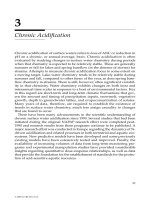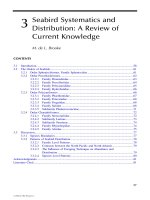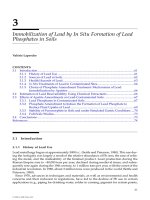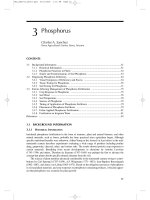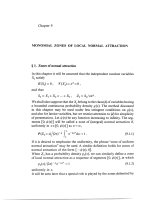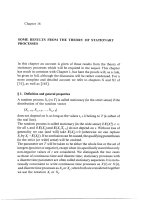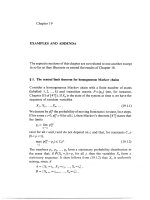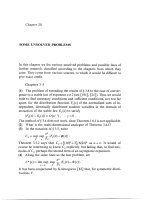Bioremediation of Relcalcitrant Compounds - Chapter 3 ppsx
Bạn đang xem bản rút gọn của tài liệu. Xem và tải ngay bản đầy đủ của tài liệu tại đây (1.28 MB, 18 trang )
33
chapter three
Roadblocks to the
implementation of
biotreatment strategies
Jeffrey W. Talley
Contents
3.1 Introduction 34
3.2 Factors affecting biodegradation 36
3.2.1 Metals 36
3.2.2 Temperature 37
3.2.3 Water 37
3.2.4 pH 37
3.2.5 Toxic compounds 38
3.2.6 Effects of soil type 38
3.2.7 Nontechnical issues 38
3.3 Treatment zones 39
3.4 Alternative physical and chemical technologies 40
3.4.1 Incineration 40
3.4.2 Air stripping 40
3.4.3 Activated carbon adsorption 40
3.4.4 Advanced oxidation 41
3.4.5 Low thermal stripping 41
3.4.6 Pump and treat 42
3.4.7 Stabilization 42
3.4.8 Dechlorination 43
3.4.9 Compost 43
3.5 Transitioning from bench-level to full-scale design 44
3.5.1 Microscale phenomena 44
3.5.2 Mesoscale phenomena 44
L1656_C003.fm Page 33 Monday, July 18, 2005 7:42 AM
© 2006 by Taylor & Francis Group, LLC
34 Bioremediation of Recalcitrant Compounds
3.5.3 Macroscale phenomena 46
3.6 Relationship between scales of observation 46
3.7 Conclusions 47
3.8 Summary 48
References 49
3.1 Introduction
Biotreatment can be broken into two basic categories:
in situ
and
ex situ
.
“With
in-situ
techniques, soil and associated groundwater are treated in place
without excavation” (Blackburn and Hafter, 1993). Examples of
in situ
tech-
niques include pump and treat, percolation (flooding), bioventing, and air
sparging. In each of these systems, the contaminated media are treated
without excavation. With
ex situ
techniques, soil and groundwater are
removed from their original locations for treatment. Examples of
ex situ
techniques include land farming, irrigation, soil treatment units, composting,
engineered biopiles, and bioreactors. Both
in situ
and
ex situ
techniques are
capable of saturated and unsaturated zone remediation, although restriction
exists depending on the exact system used. However, many factors can
influence the effectiveness of each technique. Blackburn and Hafter (1993)
(Table 3.1) evaluated the influence of these techniques for operating states
of microbiological processes (i.e., bioactivity).
In general, this study by Blackburn and Hafter showed that
ex situ
techniques allow more opportunities to control or engineer conditions for
remediation; however, this is not to suggest that
ex situ treatment is the
preferred technique. Although some sites may be more easily controlled and
maintained with ex situ
configurations, others are more effective with
in situ
treatment. For example, many sites are located in industrial and commercial
areas, and these sites normally consist of numerous structures interconnected
by concrete and asphalt. These physical barriers would make excavation
extremely difficult, and if the contamination is deep in the subsurface, exca-
vation becomes too expensive. As a result of these physical barriers, the
required excavation efforts may make
ex situ
biotreatment impracticable.
Other factors could also have an impact on the type of treatment. At a typical
site, the contamination is basically trapped below the surface. Exposing the
contamination to the open environment through excavation can result in
potential health and safety risks. In addition, the public’s perception of the
excavation of contaminants could be negative, depending on the situation.
All of these conditions clearly favor
in situ
biotreatment. Nonetheless, the
key is to carefully consider the parameters involved with each site before
evaluating which technique to use.
L1656_C003.fm Page 34 Monday, July 18, 2005 7:42 AM
© 2006 by Taylor & Francis Group, LLC
Chapter three: Roadblocks to implementation of biotreatment strategies 35
Table 3.1
Influences of Bioremediation Techniques on Bioactivity Control
In Situ
Ex Situ
Solid
Ex Situ
Slurry
Bioactivity Parameter
Pump
and
Treat Percolation
Bioventing
and Air
Sparging
Soil
Treatment
Units
Compost
Piles Biopiles Lagoon Bioreactor
Air or oxygen ++
a
0+++++ +++ ++ +++
Alternative terminal electron
acceptor
++ ++ +
b
0
b
0
b
0
b
00
b
++
pH 0 00 00 ++ + + ++ +++
Nutrients and growth factors 0 0 0 + + + ++ ++
Inoculation bioaugmentation + 00 00 + + + ++ ++
Heterogeneity 0 00 00 + + + ++ ++
Agitation or mixing 0 00 00 + + + ++ +++
Temperature 0 00 00 0 + + 0 ++
Microbial community
structure control
00 00 00 0 0 0 0 +
Water activity 00 00 00 + + + 00 00
Salinity 0 0 0 + + + + +
Control of inhibitors + 0 0 + + + + +
Containment of effluents 0 00 00 + + + + ++
Addition of treatment
chemicals
000 00 + +++ +
Note
: Although this table is an old source, it still provides an accurate summary
.
a
Key: +, ease; 0, difficulty.
b
Ability to employ alternative terminal electron acceptor influenced by ability to limit the pr
esence of air or oxygen.
Source: From Blackburn, J.W. and Hafter, W.R.,
TIBTECH
, 11 (August), 329, 1993.
L1656_C003.fm Page 35 Monday, July 18, 2005 7:42 AM
© 2006 by Taylor & Francis Group, LLC
36 Bioremediation of Recalcitrant Compounds
3.2 Factors affecting biodegradation
The microbial population follows a growth cycle that can be divided into
several distinct phases: the lag phase, exponential phase, stationary phase,
and death phase. In the lag phase, there is a delay in the microbial population
growth until the microbes have become adjusted to the food source, which
in many instances is the contaminant of interest, and surrounding conditions.
The microbes cannot consume the food source until they have developed
the required enzymes and metabolites necessary to break down the contam-
inant. After the necessary enzymes and metabolites have been produced, the
microbes enter the exponential phase of growth. The rate of exponential
growth is influenced by environmental conditions (e.g., temperature) as well
as by characteristics of the organism itself. However, exponential growth
cannot occur indefinitely. Generally, either an essential nutrient for growth
is used up or some waste product of the organism builds up to an inhibitory
level and exponential growth ceases. At this point, the population has
reached the stationary phase, in which there is no net increase or decrease
in cell number. If conditions worsen (i.e., toxins continue to build up or the
food source becomes depleted), the microbial population will enter the death
phase and the viable number of microbes will decrease (Atlas, 1984; Brock
et al., 1984).
Given this growth cycle, almost all organic compounds are degradable
provided the proper circumstances or time. However, a range of physical,
chemical, and biochemical conditions or materials can interfere with biore-
mediation. The biodegradability of wastes or specific waste constituents
must be defined in terms of a realistic period determined by the goals of the
treatment program. Biodegradability limits due to toxicity are a function of
concentration. If the concentration of the toxicant can be controlled or the
biomass is large enough, many highly toxic wastes or constituents can be
biodegraded. By incrementally increasing contaminant concentrations,
microbes can be challenged to degrade more wastes. The key is to slowly
increase the contaminant concentrations, allowing the microbe population
to adapt to the changing conditions and produce the required enzymes and
metabolites.
3.2.1 Metals
Metals can inhibit various cellular processes and their effects are often con-
centration dependent. Metal toxicity for microbes will usually involve spe-
cific chemical reactivity. Metals such as copper, silver, and mercury are typ-
ically very toxic, particularly as ions, whereas metals such as lead, barium,
and iron are usually benign to the microbes at levels typically encountered.
The nutrient metals are usually found naturally in the necessary amounts
for plants and microbes in fertile soils. The principal inorganic nutrients are
nitrogen and phosphorus; however, trace amounts of potassium, calcium,
sulfur, magnesium, iron, and manganese are also required for optimum
L1656_C003.fm Page 36 Monday, July 18, 2005 7:42 AM
© 2006 by Taylor & Francis Group, LLC
Chapter three: Roadblocks to implementation of biotreatment strategies 37
biological growth. The availability or toxicity of these metals to the microbes
is usually dependent on pH, with the metals becoming more mobile/avail-
able at lower values of pH.
Metals can be actively accumulated by certain microorganisms and plant
species. Living cells can adsorb metals and concentrate inorganics within
the cell. Although heavy metals may not be metabolically essential, they are
taken up by the biomass as a side effect of the normal metabolic activity of
the cell. Activated biomass removes metals from solution by a variety of
mechanisms, which include ion exchange at the cell walls, complexation
reactions at the cell walls, and intra- and extracellular complexation reactions
(Benemann, 1991). Inactivated biomass removes metals primarily by adsorb-
ing metals to the ionic groups either on the cell surface or in the polysac-
charide coating found on most forms of bacteria. The metals are bound by
exchange of functional groups or by sorption on polymers.
3.2.2 Temperature
Most microbes prefer to grow at temperatures in a range of about 10 to 38˚C.
The rate of biochemical reactions in cells increases with temperature up to
a maximum, above which the rate of activity declines as enzyme denatur-
ation occurs and organisms either die or become less active. Low tempera-
tures seldom kill the microbes, and with warming, the microbes typically
recover. Temperature also affects gas solubilities and must be taken into
account when designing a remediation system. However, it is extremely
difficult to control the temperature of
in situ
processes, and the temperature
of
ex situ
processes can only be moderated, sometimes with great expense.
Consequently, the effects of the expected temperatures should be factored
into the design–basis expected degradation rate.
3.2.3 Water
Microorganisms do not grow without adequate water, which is the universal
solvent for their cellular biochemicals, growth substrates, oxygen, and nutri-
ents. However, too much water may saturate the soil and result in anaerobic
activity, which may or may not be beneficial, depending on whether aerobic
or anaerobic degradation processes are preferred. If aerobic conditions are
desired, a 30 to 35% saturation of the pore spaces is usually sufficient to still
enable the passage of air through the subsurface. On the other hand, if
anaerobic conditions are desired, a 100% saturation of the pore spaces will
more than suffice.
3.2.4 pH
Extreme values of pH (i.e., pH values of <3 and >9 or 10), as well as sudden
changes in the pH of the waste-treatment system matrix, can inhibit microbial
growth by interfering with the following: (1) microbial metabolism, (2) gas
L1656_C003.fm Page 37 Monday, July 18, 2005 7:42 AM
© 2006 by Taylor & Francis Group, LLC
38 Bioremediation of Recalcitrant Compounds
solubility in soil water, (3) nutrient availability in soil water, and (4) heavy metal
solubilities. Most natural environments (i.e., soils) have pH values between 5.0
and 9.0. Consequently, this range is optimal for microbial-enhanced biodegra-
dation of waste contamination. This pH range is maintained by a natural buff-
ering capacity that exists in most fertile native soils due to the presence of
carbonates and other minerals. However, this buffering capacity can be
depleted over time as a result of acidic by-products of degradation. Although
microbes can adapt to a broader range of pH values, there typically is an
accompanying decrease in growth/metabolic rates. Likewise, there is a reduc-
tion in the variety of microbial strains, with the microbes themselves becoming
more specialized for living under certain environmental conditions.
3.2.5 Toxic compounds
Just as contaminant concentrations that are too low can complicate bioreme-
diation, high aqueous phase concentrations of some contaminants can create
problems. At high concentrations, some chemicals are toxic to microbes, even
if the same chemical is readily degraded at lower concentrations. Toxicity
prevents or slows metabolic reactions and often prevents the growth of new
biomass needed to stimulate rapid contaminant removal. The degree and
mechanisms of toxicity vary with specific toxicants, their concentration, and
the exposed microorganisms. Microbial cells cease to function when at least
one of the essential steps in their numerous physiological processes is
blocked. The blockage may result from gross physical disruption of the cell
structure or competitive binding of a single enzyme essential for metaboliz-
ing the toxicant (National Research Council, 1993).
By design, some organic compounds are toxic to targeted life forms such
as insects and plants and may also be toxic to microbes. These compounds
include herbicides, pesticides, rodenticides, fungicides, and insecticides. In
addition, some classes of inorganic compounds such as cyanides and azides
are toxic to many microbes; however, these compounds may be degraded
following a period of microbial adaption.
3.2.6 Effects of soil type
The soil type affects the rate of mass transport of nutrients, contaminants,
water, air (i.e., oxygen), and pH adjusters. This effect on mass transport in
return affects the operation of the degradation process and the potential for
migration of the wastes and amendments. In addition, highly organic soils
can be sorptive and act as a barrier to organic migration.
3.2.7 Nontechnical issues
As already established, the technical parameters for biotreatment can be
complex and numerous; however, nontechnical issues are also of vital impor-
tance for an effective design. Some considerations may include the following:
L1656_C003.fm Page 38 Monday, July 18, 2005 7:42 AM
© 2006 by Taylor & Francis Group, LLC
Chapter three: Roadblocks to implementation of biotreatment strategies 39
• Ability to achieve cleanup levels
• Cost with respect to other treatment options
• Risk assessment of site before, during, and after treatment
• Regulatory acceptance and familiarity
• Public perception
•Time constraints
• Space limitations
Although there are many other criteria that can influence the design, the
most basic objective for biotreatment is to design a system that will optimize
microbial conditions. If the fundamental parameters exist for microbial
growth (i.e., adequate supply of nutrients) and favorable conditions are
maintained (i.e., optimal temperature and pH), biotreatment has the poten-
tial to be exceptionally effective.
3.3 Treatment zones
When considering bioremediation, two zones for treatment must be consid-
ered: unsaturated and saturated. The unsaturated zone (vadose zone) is “a
composite or materials coexisting in the solid, liquid, and gaseous phases”
(Tursman and Cork, 1992). The unsaturated zone contains solid particles of
variable sizes interconnected with water and air. The amount of water and
air contained within these pore spaces depends on the lithology, recharge
characteristics, and discharge characteristics of the site (Tursman and Cork,
1992). The water contained in these pore spaces slowly percolates downward
under the influence of gravity until it reaches the saturated zone. The unsat-
urated zone is normally the easiest to treat because its characteristics favor
chemical, biological, and physical interactions.
The saturated zone is that region where 100% of the pore volume con-
tains liquid water (Tursman and Cork, 1992). This region is where
water-bearing formations will yield groundwater. If groundwater is in suf-
ficient quantity, it is referred to as an aquifer. Unlike the unsaturated zone,
chemical, biological, and physical interactions can be limited. This charac-
teristic makes the saturated zone the most difficult region for biotreatment.
The water table divides the saturated and unsaturated zones. Typical pat-
terns of contamination occur in both zones. Frequently, the contamination
drains through the unsaturated zone, leaving a portion that is trapped by
capillary forces. If the contaminant is volatile, a plume of vapors fills the soil
air in the vadose zone. Some contaminants drain or pass further into the
water table and then spread laterally. Groundwater moving through the
aquifer comes into contact with the contaminants and transports the
water-soluble components. Therefore, it is not uncommon to deal with three
distinct regions of contamination:
•A plume of vapors in the soil air
•A groundwater solute plume
• The region that contains the source of contamination
L1656_C003.fm Page 39 Monday, July 18, 2005 7:42 AM
© 2006 by Taylor & Francis Group, LLC
40 Bioremediation of Recalcitrant Compounds
3.4 Alternative physical and chemical technologies
Several alternative remediation technologies, excluding biological processes,
are described below. This section will give background on technologies that
are currently available for site remediation. The advantages and disadvan-
tages of these technologies can be compared with bioremediation to show
that in many cases bioremediation will be the treatment technology of choice.
However, each site has unique characteristics that may favor one treatment
technology over another. The appropriateness of each technology must be
evaluated prior to choosing one and implementing a remediation strategy.
3.4.1 Incineration
Incineration is a technology that results in the complete destruction of
organic compounds using high temperatures. Typical operating tempera-
tures are in excess of 1500˚F. For most site remediation applications, incin-
erators are used for the treatment of contaminated soils and free products.
Although the incineration of liquid is possible, it is typically not used to
remediate groundwater and surface water from contaminated sites. The fact
that incineration is a destructive technology that results in the complete
destruction of organic contaminants is a major advantage. Disadvantages of
this technology involve the high cost of operation, poor public acceptance,
and regulatory constraints.
3.4.2 Air stripping
Air stripping is a physical treatment process that relies on contaminant phase
change. This process removes contaminants through volatilization from the
aqueous phase into the gas phase; consequently, it is not a destructive tech-
nology. The higher the contaminant’s Henry’s law constant, the easier it is
to desorb or “strip” the compound from the aqueous phase to the air phase.
For air stripping to be cost effective, the contaminant must be significantly
more volatile than water. Air stripping is commonly used to remove volatile
organic compounds from contaminated groundwater. Dissolved cations
such as iron can present problems with stripper operation by oxidizing and
precipitating out in the column, thereby clogging the column. Many states
are now requiring treatment of off-gases from air stripping units, which can
significantly increase the cost of treatment because of disposal problems
associated with spent activated carbon. Also, recent emphasis on destructive
technologies is limiting the acceptance and use of this technology by the
regulatory community (Zappi et al., 1993).
3.4.3 Activated carbon adsorption
Activated carbon adsorption is a treatment process generally used for
the removal of dissolved organics, color, and taste- and odor-causing
L1656_C003.fm Page 40 Monday, July 18, 2005 7:42 AM
© 2006 by Taylor & Francis Group, LLC
Chapter three: Roadblocks to implementation of biotreatment strategies 41
compounds in water through adsorption of the contaminant onto the surface
of the carbon. The most frequently used form of activated carbon is granular
activated carbon (GAC). The activated carbon process is not a destructive
technology because it involves a phase change of the contaminants from the
aqueous phase into the solid phase. The phase transfer of GAC treatment
results in a concentrating effect of the contaminants onto the GAC surface.
However, because the contaminant is not destroyed, the spent carbon must
be either disposed of, usually as hazardous waste, or regenerated, which can
be very costly. Logistic and economic disadvantages arise from the need to
transport and decontaminate spent carbon and, therefore, waste streams
with high contaminant concentration levels are typically pretreated.
3.4.4 Advanced oxidation
Advanced oxidation processes (AOPs) are destructive technologies. These
processes typically rely on the synergistic effect of both ultraviolet (UV) light
or other catalysts and chemical oxidizers for the destruction of organic com-
pounds. Hydrogen peroxide and ozone are examples of commonly used
chemical oxidizers. Four different ultraviolet oxidation processes have been
evaluated by the U.S. Army Environmental Center (USAEC) at both the
bench and pilot scales. The demonstration site for this evaluation was the
Savannah Army Depot Activity in Illinois. The evaluation showed that ultra-
violet oxidation technology is effective and cost competitive (when com-
pared with the current technology of utilizing granular-activated carbon) in
treating groundwater contaminated with explosives.
Problems typically associated with AOPs include fouling of the UV
quartz due to solubilized cations and the formation of chemical intermedi-
ates caused by incomplete oxidation of the parent compounds. A way to
minimize the effects of fouling is to treat the water prior to its treatment by
an AOP. Typical pretreatment processes include flocculation, filtration, pH
adjustment, oxidant addition, and additive addition. Another drawback of
AOPs is the relatively high operational cost caused by the electrical require-
ments of these systems.
3.4.5 Low thermal stripping
Low thermal stripping uses elevated temperatures to desorb organic con-
taminants from contaminated soils. It is a physical separation process and
is not designed to destroy organics; however, this process can be a destructive
one if the vapors produced in the desorption device are destroyed in a
secondary destruction unit. The target contaminant groups for this technol-
ogy are nonhalogenated volatile organic compounds and fuels, although it
can be used to treat semivolatile organic compounds at reduced effective-
ness. A drawback of the technology is that it can be expensive to operate,
depending on the fate of the gases. Also, the presence of heavy metals in the
feed stream may produce a treated solid residue requiring stabilization.
L1656_C003.fm Page 41 Monday, July 18, 2005 7:42 AM
© 2006 by Taylor & Francis Group, LLC
42 Bioremediation of Recalcitrant Compounds
Likewise, dewatering of saturated solids is necessary because all of the
moisture has to be driven off before contaminants can be efficiently desorbed.
3.4.6 Pump and treat
Pump-and-treat methods pump any contaminated water from the ground
and treat it either at an on-site plant or off-site. The advantage of this system
is that the contaminant is actually removed entirely from this system. This
is one of the most traditional methods of remediation, but it is not the most
effective method for all contaminants. For contaminants that bind very
closely to the soil, such as polycyclic aromatic hydrocarbon (PAHs), desorp-
tion of the contaminant from the soil to the groundwater is very slow. When
the groundwater is pumped out of the system, the contaminant present in
the aqueous phase is also removed, but a significant portion of the contam-
inant still remains present in the ground and will leach out in the future. In
order for pump and treat to be effective, it must be done over a long period,
in order to give the contaminant sufficient time to desorb from the soil.
However, this option becomes much more cost efficient and timely with the
addition of surfactants, such as amphiphilic polyurethane nanoparticles,
extracellular polymers, and cyclodetrins, that will loosen the bond of the
contaminant to the soil particles and increase the apparent solubility of the
contaminant (Tungittiplakorn et al., 2004). The addition of surfactants will
greatly increase the mass recovery rate for this method.
3.4.7 Stabilization
In stabilization, the contaminant is trapped within the soil matrix and is
effectively removed from being a future threat. It is a nondestructive method
and relies on the strength of the bond between the contaminant and the soil
particles or additive for its immobilization. The contaminated soil is then
often removed and placed in a landfill. Unfortunately, this method can cause
the volume of the soil to increase by as much as 20%, which increases
disposal costs. Stabilization can occur in two ways — through either covalent
bonding or pore trapping. Binding occurs when the contaminant actually
becomes part of the binder (such as cement or fly ash). Entrapment occurs
when the contaminant becomes trapped in the pores of an additive, but that
contaminant may be released if that additive is ever crushed (Magar, 2003).
Stabilization requires leaching monitoring in order to confirm that the con-
taminant stays locked in the matrix. Because the contaminant is not
destroyed, there is a possibility that it could be removed in the future.
One form of stabilization that has been examined recently is the use of
plants to trap the contaminant and also increase microbial growth so that
the contaminant can be destroyed. Phytoremediation, as this is called, con-
tains two components: phytodecontamination, which removes the contam-
inant from the soil by taking it up into the plant, and phytostabilization, in
which the plant helps to lock the contaminant in place. The latter is often
L1656_C003.fm Page 42 Monday, July 18, 2005 7:42 AM
© 2006 by Taylor & Francis Group, LLC
Chapter three: Roadblocks to implementation of biotreatment strategies 43
done due to the increase of organic material in the soil, which increases the
ability of contaminants such as PAHs to adsorb to the soil particles (Tugun
et al., 2003). Furthermore, this organic material contains many molecules
that stimulate microbial growth, and those microbes can consume the immo-
bilized contaminant (Kamath et al., 2004). The plants improve microbial
productivity by aerating the soil subsurface with their roots and by removing
much of the moisture in the soil through evapotranspiration. Both of these
actions create an aerobic environment in which the microbes can be very
effective (Tugun et al., 2003). The main disadvantage is that this form of
remediation can only be done close to the surface and does not affect any
contamination deeper in the soil.
3.4.8 Dechlorination
Aerobic bacteria can break down only chlorinated substances with fewer
than five chlorine substituents. In dechlorination, anaerobic bacteria remove
one or more of the chlorine atoms and replace it with a hydrogen ion,
resulting in a compound that is less toxic, less carcinogenic, and easier to
break down. The effectiveness of this process increases with the increase in
contaminant concentration (Magar, 2003). Dechlorination can also be done
through chemical and mechanical means. When chlorinate substances are
mixed with metallic calcium in a ethanol solvent and mixed for 24 hours
under atmospheric pressure and at room temperature, the polychlorinated
compounds lose chlorine ions and become more easily degradable. The
advantage of this process is that it does not require high temperatures and
pressures, which could potentially make it cost effective. This method is still
in the experimental stages and not ready for use on a large scale (Mitoma
et al., 2004). The major drawbrack to this method is that dechlorination used
by itself often does not meet regulatory standards for contaminant removal.
These standards are often based on mass removal instead of toxicity reduc-
tion, even though toxicity reduction makes contaminated soils as safe as
other methods do (Magar, 2003). Dechlorination, therefore, must be done in
conjunction with another remediation technique.
3.4.9 Compost
Compost has long been used to degrade sewage, food wastes, and yard
wastes, but it is now also being used to degrade certain contaminants, such
as explosives and PAHs. Contaminated soil is removed from the ground and
mixed with natural materials such as cow manure, activated sludge, and
corn cobs. These additives provide the biomass necessary for microbial
growth and worm growth. The worms aerate the soil, and the microbes
destroy the contaminant. The compost naturally goes through stages of
microbial growth and decline, which self-regulates the system. Once the
compost is mixed with the contaminated soil, the only human action required
is an occasional turning of the pile. The disadvantage is that this method
L1656_C003.fm Page 43 Monday, July 18, 2005 7:42 AM
© 2006 by Taylor & Francis Group, LLC
44 Bioremediation of Recalcitrant Compounds
does not work on more complex contaminants, such as five- and six-ring
compounds (Potter et al., 1999). Currently, it is also a very inexact method
for remediation.
3.5 Transitioning from bench-level to full-scale design
Systems at the bench level are relatively simple by design, whereas systems
naturally occurring in the field can be complex. The bench level focuses on
specific aspects of a process (i.e., ascertaining rates of degradation). Individ-
ual parameters (i.e., concentration and type of contaminant, species of micro-
organism, etc.) are controlled and varied so that their relative impacts on the
overall process can be measured. In many instances, a homogeneous soil
and single type of contaminant are used for these experiments. These bench
experiments are run in order to gather information on the degradation pro-
cesses so that the information can be applied to full-scale site remediation
designs. However, many field sites consist of heterogeneous soil and a mix-
ture of contaminants, which may alter the degradation rates. Therefore,
difficulty exists in scaling up processes from the bench level to the field level
due to competing and inhibiting factors. In order to assist with this transition,
three scales of observation will be outlined so that limiting processes at each
level can be identified.
3.5.1 Microscale phenomena
The microscale is the scale at which chemical and microbiological species
and reactions can be identified independent of any transport phenomena.
The dimension of this scale is analogous to the size of the microbial cell,
which is approximately 10
–6
to 10
–5
m. This is the level at which most bench
experiments focus (Figure 3.1). When assessing the limiting factors at this
scale, the underlying question is:
Can the bugs eat the contaminant?
Other associated issues that pertain to this scale involve the following:
determining the concentration of degrading microorganisms at the site (i.e.,
the technique used to count the microbes), factors limiting biotransformation
and whether it can achieve acceptable regulatory levels for the contaminant,
and the relationship between laboratory kinetics and field kinetics.
3.5.2 Mesoscale phenomena
The mesoscale is the scale at which transport phenomena and system geom-
etry are apparent at the pore channel, soil particle, or microbial aggregate
level (Figure 3.2). The approximate dimension of this scale is 10
–5
to 10
–2
m.
When assessing the limiting factors at this scale, the underlying question is:
Can the bugs get to the contaminant?
Other associated issues that pertain to this scale include the extent to which
sorption and interphase transport influence the rate of bioremediation.
L1656_C003.fm Page 44 Monday, July 18, 2005 7:42 AM
© 2006 by Taylor & Francis Group, LLC
Chapter three: Roadblocks to implementation of biotreatment strategies 45
Figure 3.1
Microscale: A view through an electron microscope of a silica particle. Concentrations of various P
AHs vary significantly
between different locations in the same particle. The distances are in microns (
µ
m). (Source: Talley et al., 2001.)
50
2
0
0.01
0.02
0.03
0.04
0.05
0.06
0.07
178 202 228 252 276
PAH Mass Number
µL
2
MS PAH Signal
0
0.01
0.02
0.03
0.04
0.05
0.06
0.07
178 202 228 252 276
PAH Mass Number
µL
2
MS PAH Signal
Acc.V Spot Magn
15.0 kV 3.0 500x
Det WD
SE 20.7 Upal
50 µm
Acc.V Spot Magn
15.0 kV 3.0 15000x
Det WD
SE 20.7 Upal
50 µm
L1656_C003.fm Page 45 Monday, July 18, 2005 7:42 AM
© 2006 by Taylor & Francis Group, LLC
46 Bioremediation of Recalcitrant Compounds
3.5.3 Macroscale phenomena
The macroscale is the scale at which advective or mixing phenomena can be
observed. The dimension of this scale is 10–2 to 102 m or larger and incor-
porates the entire field site (Figure 3.3). When assessing the limiting factors
at this scale, the underlying question is:
Are the conditions optimal for the bugs
to work?
Other associated issues that pertain to the scale include the following:
the impact of spatial heterogeneity on bioremediation of the site, the effects
of advective-dispersive transport on the rate of biodegradation at the site,
and the ability of an engineered system to effectively influence the limiting
phenomena.
3.6 Relationship between scales of observation
The three scales of observation have been developed in order to organize
and identify limiting phenomena that may apply to implementation of
Figure 3.2
Mesoscale: Mesocosm study displaying laboratory work at the bench level
at the Hazardous Waste Research Center, ERDC.
L1656_C003.fm Page 46 Monday, July 18, 2005 7:42 AM
© 2006 by Taylor & Francis Group, LLC
Chapter three: Roadblocks to implementation of biotreatment strategies 47
bioremediation at a site. Table 3.2 lists the phenomena influencing bioreme-
diation at each level of observation. It is important to note that observations
made at one scale may not apply to another scale. For example, field-mea-
sured half-lives tend to be longer than laboratory-measured values. This
variance may be caused by the impact of any or all of the limiting factors at
each level of observation on the overall system. For example, the microscale
may be limited by a low concentration of degrading microorganisms,
whereas at the mesoscale, a low-porosity soil (such as a tight clay) may limit
the ability of the microorganisms to reach the contaminant. Furthermore, the
heterogeneity of the site (e.g., multiple types of contaminant and the inter-
jection of clay lenses in a silty sand) may be the limiting factor at the mac-
roscale. Therefore, it is necessary to consider each scale of observation prior
to developing a full-scale remediation design.
3.7 Conclusions
For a remediation design to be successful, the limiting factors at each scale
must be identified so that their impacts can be minimized as much as pos-
sible. This evaluation involves an iterative process. However, sometimes a
limiting factor cannot be changed; e.g., the presence of multiple types of
contaminants or the optimization of a limiting factor may cause another
parameter to become limiting. The iterative process can demonstrate
whether a treatment technology, such as
in situ
bioremediation, is cost effec-
tive for a site. It is easier to tailor a treatment technology to a site rather than
Figure 3.3
Macroscale: Hazardous waste site showing spatial heterogeneity of
contamination.
L1656_C003.fm Page 47 Monday, July 18, 2005 7:42 AM
© 2006 by Taylor & Francis Group, LLC
48 Bioremediation of Recalcitrant Compounds
alter a site to fit a specific technology. It is imperative to keep an open mind
about possible treatment technologies. Because each site has unique charac-
teristics, a feasibility study can determine limiting factors and the appropri-
ate remediation technology to be implemented. In transitioning from the
bench to the field, observations at each scale must be understood and incor-
porated into a cost-effective remediation design.
3.8 Summary
The Department of Defense (DOD) has more than 21,000 contaminated sites
requiring some form of remediation. Contaminants on these sites include
explosive compounds (i.e., trinitrotoluene (TNT), cyclotrimethylenetrinitra-
mine (RDX), high melting point explosive (HMX)), chlorinated solvents (i.e.,
tetrachloroethylene (PCE), trichloroethylene (TCE), TCA), PAHs (i.e.,
benzo-a-pyrene), and polychlorinated biphenyls (PCBs) (i.e., Aroclors). Cur-
rent technology has centered around incineration, air stripping, and the
Table 3.2
Phenomena Influencing Bioremediation
Phenomena Representative Characterization Method
Microscale
Microorganism
Degradation pathways
Reaction stoichiometry
Reaction kinetics
Electron acceptors
Nutrients
Inhibitors, toxicity
Water activity, pH
Reactions with soil or aquifer matrix
Chemical equilibria
Sorption (equilibrium)
Plate counts, gene probes
Batch reaction studies
Batch reaction studies
Batch reaction studies
Chemical analysis
Chemical analysis for nitrogen and
phosphorus
Batch reaction studies
Electrochemical probes
Abiotic reaction studies
Abiotic batch sorption studies
Mesoscale
Sorption (nonequlibrium)
Attachment/detachment
(microorganisms)
Diffusion
Plugging/filtration
Interphase transport
Abiotic batch and column sorption studies
Biofilm studies, attached microbe
enumeration
Column studies, pressure drop and flow rate
Multiphase column studies
Macroscale
Advection Well elevations, pump tests, tracer studies
Dispersion Conservative tracer studies
Spatial heterogeneity Well logs, core permeabilities
Hydrologic properties and
boundary conditions
Same as for advection and dispersion
Source
: Adapted from Sturman et al., 1995.
L1656_C003.fm Page 48 Monday, July 18, 2005 7:42 AM
© 2006 by Taylor & Francis Group, LLC
Chapter three: Roadblocks to implementation of biotreatment strategies 49
use of activated carbon. Frequently, this technology is not cost effective or
publicly acceptable. Biotreatment offers a possible alternative. Biotreatment
can cost effectively eliminate contaminants and avoid the use of harsh chem-
icals and physical treatments. However, special care must be employed to
ensure that the proper remediation system is designed and engineered to
optimize cleanup and minimize costs.
Unfortunately, not all bioremediation efforts have been successful. In an
attempt to develop bioremediation technology from the flask (bench scale)
to the field (full-scale design), many scientists and engineers have failed to
understand the phenomena that influence bioremediation. Issues such as
additional mass transport mechanisms/limitations, the presence of multiple
phases, spatial heterogeneities, and unfavorable factors for bacterial growth
represent only a few of the phenomena that can limit or complicate biodeg-
radation. Successful bioremediation requires a complete examination of the
phenomena that can be observed as the scientist and engineer progress
together from the bench to the field.
An excellent way to examine these phenomena is to use the conceptual
scales of observation: microscale, mesoscale, and macroscale (Sturman et al.,
1995). The microscale represents the level at which chemical and microbial
species and reactions can be characterized independently of any transport
phenomena. These activities are those occurring at the microbial cell level
and generally are the focus of bench-level work. The mesoscale is the level
at which transport phenomena and system geometry are first apparent, with
the exclusion of advective or mixing processes. This scale represents those
activities that occur at the pore channel, soil particle, or microbial aggregate
level. The macroscale is the scale at which one has the ability to discern
advective or mixing phenomena. These activities are generally associated on
a site level and are the focus of the design engineer. The critical path as
bioremediation technology is developed from flask to field is to observe and
understand the phenomena that exert influence at each scale of observation
so that its effects can be incorporated into the final remediation design.
References
Atlas, R.M. 1984.
Microbiology Fundamentals and Applications
. Macmillan Publishing
Company, New York.
Benemann, J.R. 1991.
Literature Review on the Use of Bioaccumulation for Heavy Metal
Removal and Recovery
, WSRC-TR-175-Vol. 2 (February). Westinghouse Savan-
nah River Co., Aiken, SC.
Blackburn, J.W. and Hafter, W.R. 1993. The input of biochemistry, bioavailability, and
bioactivity on the selection of bioremediation techniques.
TIBTECH
11 (Au-
gust): 329.
Brock, T.D., Smith, D.W., and Madioan, M.T. 1984.
Biology of Microorganisms
, 4th ed.
Prentice Hall, Englewood Cliffs, NJ.
L1656_C003.fm Page 49 Monday, July 18, 2005 7:42 AM
© 2006 by Taylor & Francis Group, LLC
50 Bioremediation of Recalcitrant Compounds
Kamath, R., Schnoor, J.L., and Alvarez, P.J.J. 2004. Effect of root derived substrates
on the expression of nah-lux genes in
Pseudomonas flourescens
HK44: implica-
tions for PAH biodegradation in the rhizosphere.
Environ. Sci. Technol.
38:
1740–1745.
Magar, V.S. 2003. PCB treatment alternatives and research directions.
J. Environ. Eng.
129: 961–964.
Mitoma, Y., Uda, T., Egashira, N., Simion, C., Tashiro, H., Tashiro, M., and Fan, X.
2004. Approach to highly efficient dechlorination of PCDDs, PCDFs, and
coplanar PCBs using metallic calcium in ethanol under atmospheric pressure
at room temperature.
Environ. Sci. Technol.
38: 1216–1220.
National Research Council. 1993.
In Situ Bioremediation: When Does It Work?
National
Academy Press, Washington, DC.
Potter, C.L., Glaser, J.A., Chang, L.W., Meier, J.R., Dosani, M.A., and Herrmann, R.F.
1999. Degradation of polynuclear aromatic hydrocarbons under bench-scale
compost conditions.
Environ. Sci. Technol.
33: 1717–1725.
Sturman, P.J., Stewart, P.S., Cunningham, A.B., Bouwer, E.J., and Wolfram, J.H. 1995.
Engineering scale-up of in-site bioremediation processes: a review.
J. Contam-
inant Hydrol.
19: 171–203.
Talley, J.W., Ghosh, V., Luthy, R.G., Gillette, S., Zane, R.N., Furey, J.S., Felt, D.R., and
Tucker, S. 2001. Assessment and prediction of biostabilization of polycyclic
aromatic hydrocarbons in sediments. CU 1059 Report, SERDP, Arlington, VA.
Tugun, H., Loehr, R.C., and Qui, X. 2003. Natural stabilization of stored industrial
sludges.
J. Environ. Eng.
129: 248–257.
Tungittiplakorn, W., Lion, L.W., Cohen, C., and Kim, J.Y. 2004. Engineered polymeric
nanoparticles for soil remediation.
Environ. Sci. Technol.
38: 1605–1610.
Tursman, J.F. and Cork, D.J. 1992. Subsurface contaminant bioremediation engineer-
ing.
Crit. Rev. Environ. Control
22, 1–26.
Zappi, M.E., Gunninson, D., Penington, J., Cullinane, M.J., Teeter, C.L., Brannon, J.M.,
Meyers, T.E., Banerji, S., and Sproull, R. 1993.
Technical Approach for In Situ
Biological Treatment Research: Bench-Scale Experiments
, Technical Report IR-
RP-93-3. U.S. Army Engineer Waterways Experiment Station, Vicksburg, MS.
L1656_C003.fm Page 50 Monday, July 18, 2005 7:42 AM
© 2006 by Taylor & Francis Group, LLC
